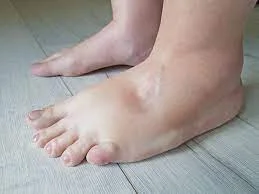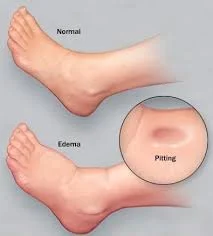How to Get Rid of Foot Oedema?
Table of Contents
Introduction
Take a contrast bath, drink diuretic tea, drink plenty of water throughout the day, and raise your legs to relieve foot oedema. These methods improve blood and lymphatic circulation, promote venous return, promote fluid elimination, and relieve oedema in the feet and ankles.
Oedema ankles can occur as a result of normal ageing, pregnancy, or prolonged standing. However, they can also indicate a health problem such as venous insufficiency, kidney failure, heart failure, or thrombosis.
Home remedies for feet. Oedema can help reduce puffiness and be used in conjunction with prescribed medical treatment. However, if you notice oedema on only one side or if it is accompanied by symptoms such as shortness of breath, sudden swelling, skin redness, or chest pain, go to the emergency room right away.
What is oedema?
Oedema is a medical term that describes swelling caused by fluid trapped in your body’s tissues. Edoema is most commonly found in the feet, ankles, and legs but can also affect the face, hands, and abdomen.
Oedema is a common pregnancy side effect that can also indicate more serious illnesses such as liver failure and heart problems. This condition can be caused by both malignant and inflammatory diseases. People with heart failure, kidney disease, cirrhosis, or diabetes are more likely to develop oedema.
What is a Foot Oedema?
Foot edema, also known as swelling, is a common condition characterized by an accumulation of fluid in the tissues of the foot. It can be caused by various factors such as prolonged standing or sitting, injury, pregnancy, obesity, or underlying medical conditions like kidney or heart disease. Foot edema can be uncomfortable and may affect mobility and quality of life if left untreated.
Managing foot edema involves a combination of lifestyle changes, home remedies, and medical interventions aimed at reducing swelling and addressing underlying causes. This guide will explore effective methods to alleviate foot edema and improve overall foot health.
Ways to get rid of foot oedema
Use compression socks.
Some people have swollen feet due to venous insufficiency, which occurs when blood collects in the legs and fails to pump back to the heart effectively.
Compression socks may be an option in this case, as well as for people who suffer from lymphedema, a condition in which lymph fluid accumulates and causes swelling.
However, if you have peripheral arterial disease, you should avoid compression because it may affect blood supply.
Compression socks come in a range of weights and compression levels. It may be best to begin with lighter-weight socks and then find the type that provides the most relief.
Stay hydrated.
When dehydrated, your body will store water rather than excrete it through urine or sweat. This reaction causes swelling. If you have oedema, drink at least 8 glasses of water per day to alleviate the condition.
It is also advisable to avoid alcohol. This is because alcohol dehydrates the body, causing it to remove fluids from the blood more quickly than other liquids. Fluids pass through your renal system, which includes the bladder, ureter, and kidney.
Try lymphatic drainage.
Lymphatic drainage massage reduces water retention by manipulating specific areas of your body to increase the flow of lymph fluids.
Lymphatic drainage massage techniques include one-way pumping, long stroking, and kneading. These massage techniques use your hands or instruments to pump or massage the lymph nodes in your legs.
Epsom salts
Magnesium deficiency is linked to increased inflammation throughout the body, which often results in swelling. Epsom salts include magnesium, which can be absorbed by the skin. Bathing or soaking your feet in a tub of water containing Epsom salts may help reduce inflammation and swelling in the ankles by increasing magnesium levels.
Elevation
Elevating your feet allows gravity to assist in the venous drainage of blood from your feet back to your heart. Because your feet and ankles are located below the level of your heart for the majority of the day, fluid can build up in those areas if your circulation is poor.
Veins work hard to pump blood back to the heart against gravity, so elevating your legs can help reduce your veins’ workload and allow blood to circulate more easily.
Get moving.
Exercise is essential in preventing oedema. Exercising improves muscle function, which promotes proper blood flow throughout the body.
As much as possible, avoid sitting or standing for extended periods. Instead, get up and move around, or try stretching your legs.
Physical activity.
Try to stay physically active. It is not recommended to sit or stand for long periods without moving.
Moving helps to activate the muscles in the affected body area, especially the legs. This may help to pump the excess fluid back into the heart. While travelling, get up and walk around, especially if you’re flying.
Avoid alcohol.
Avoid consuming alcoholic drinks. If drinking alcohol causes recurring swelling, it may indicate a problem with the kidneys, liver, or heart.
Magnesium-enriched foods
Magnesium deficiency causes water retention in the body. Eating magnesium-rich foods such as tofu, spinach, cashews, almonds, dark chocolate, broccoli, and avocados can help prevent oedema.
Increase potassium-rich foods.
High blood pressure and water retention are signs of potassium deficiency. Consume potassium-rich foods such as sweet potatoes, bananas, salmon, chicken, and white beans. If you have kidney problems, consult your doctor before increasing your potassium consumption.
Manage your weight.
There is mounting evidence of a link between obesity and oedema.
A heavy body weight can impair blood circulation, resulting in swelling of the lower extremities.
It can also put additional strain on the feet, causing discomfort while walking. Difficulty walking can lead to a more sedentary lifestyle, which increases the risk of swelling.
Dress in loose clothes.
Stay away from constricting or excessively tight apparel. Instead, dress loosely so you can move freely. This ensures that lymph and blood circulate freely.
It is also recommended to avoid wearing restrictive footwear. Choose to go barefoot or in flat sandals instead.
Summary
Foot oedema is a medical condition characterized by swelling caused by fluid trapped in the body’s tissues. It can occur due to normal ageing, pregnancy, prolonged standing, or serious health problems such as venous insufficiency, kidney failure, heart failure, or thrombosis. To treat foot oedema, take a contrast bath, drink diuretic tea, stay hydrated, and elevate your legs.
Compression socks can help reduce swelling in the feet and ankles due to venous insufficiency, lymphedema, or peripheral arterial disease. Staying hydrated is essential for reducing swelling, and alcohol should be avoided. Lymphatic drainage massage techniques can help increase lymph fluid flow in the legs. Epsom salts, which contain magnesium, can help reduce inflammation and swelling in the ankles. Elevating feet allows gravity to assist in venous drainage, reducing vein workload and allowing blood to circulate more easily.
Exercise is essential for preventing oedema, and staying physically active can activate muscles in affected areas. Avoiding alcohol and consuming magnesium-enriched foods can help prevent oedema. Increase potassium-rich foods, such as sweet potatoes, bananas, salmon, chicken, and white beans, to reduce high blood pressure and water retention.
Managing weight is crucial for preventing foot oedema, as obesity can impair blood circulation and cause discomfort while walking. Dress loosely and avoid restrictive footwear, opting for barefoot or flat sandals instead.
FAQs
Exercise regularly to improve circulation in your body.
Raise the affected area of your body to a level above your heart regularly.
Massage the area with oedema.
To maintain pressure on the oedema, apply bandages or compression socks.
Consume less salt.
When possible, elevate your legs or the swollen area on a chair or with pillows.
Get some gentle exercise, such as walking, to help your blood flow.
Wear wide, comfortable shoes with a low heel and a soft bottom.
To avoid infections, keep your feet clean, dry, and moisturised.
Walking and wearing elastic stockings can help reduce leg oedema and pain throughout the day.
Edoema cannot be “cured.” Edoema can only be treated by addressing the underlying cause. However, there are some things you can do to keep the swelling down. When you’re lying down, place a pillow under your legs. Wear support stockings, which can be purchased at most pharmacies.
Swimming, walking, and biking are the most effective exercises for reducing leg swelling. Exercising in a pool is ideal for swelling because the water provides full-body compression. This allows fluid to travel from the tissues to the vessels, returning fluid to the circulation.
References:
- Home Remedies to Treat Edema in Legs and Feet | CVM. (n.d.). https://www.cvmus.com/blog/home-remedies-treat-edema-legs-and-feet
- Makhija, N. (n.d.). Edema: View Causes, Symptoms and Treatments | 1mg. 1mg. https://www.1mg.com/diseases/edema-93?wpsrc=Google+Organic+Search
- Mfa, J. H. M. M. (2024, February 6). 10 Home Remedies for Swollen Feet. Healthline. https://www.healthline.com/health/home-remedies-for-swollen-feet#reduce-salt
- Edema – Diagnosis and treatment – Mayo Clinic. (2023, July 28). https://www.mayoclinic.org/diseases-conditions/edema/diagnosis-treatment/drc-20366532
- Dpt, K. G. P. (2023, April 26). 7 Ways to Get Rid of Swollen Ankles Fast. Verywell Health. https://www.verywellhealth.com/reduce-swollen-ankles-5214716







